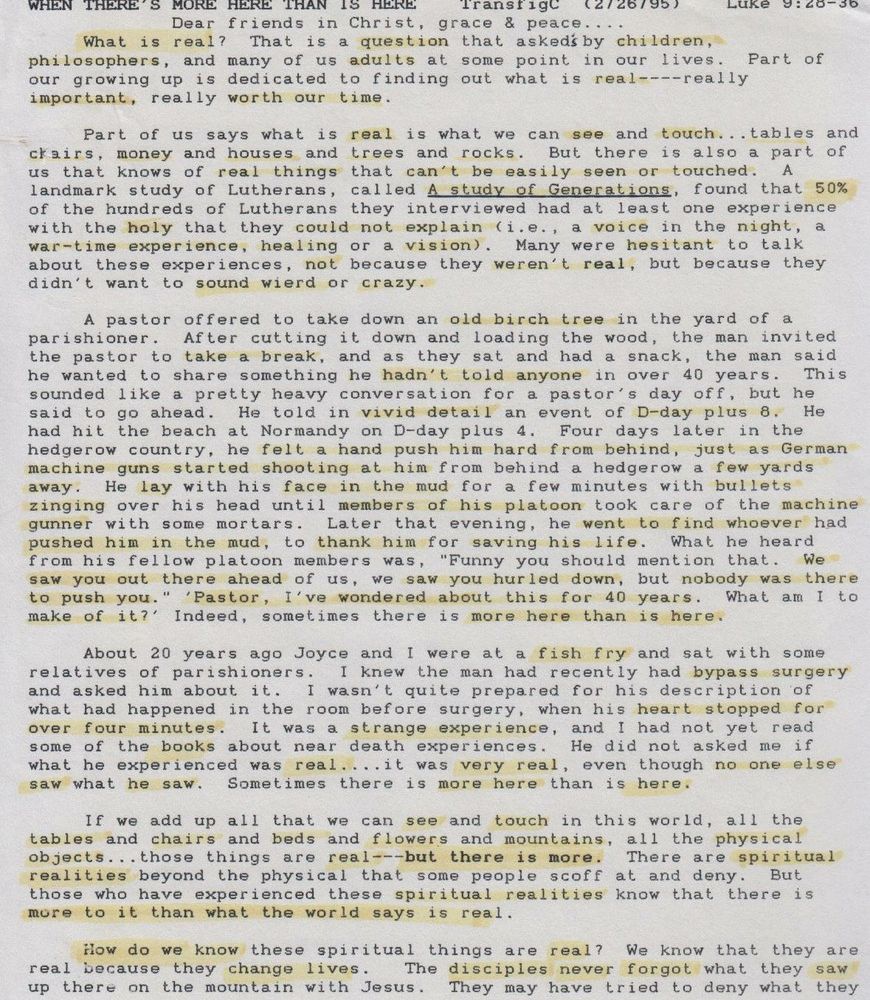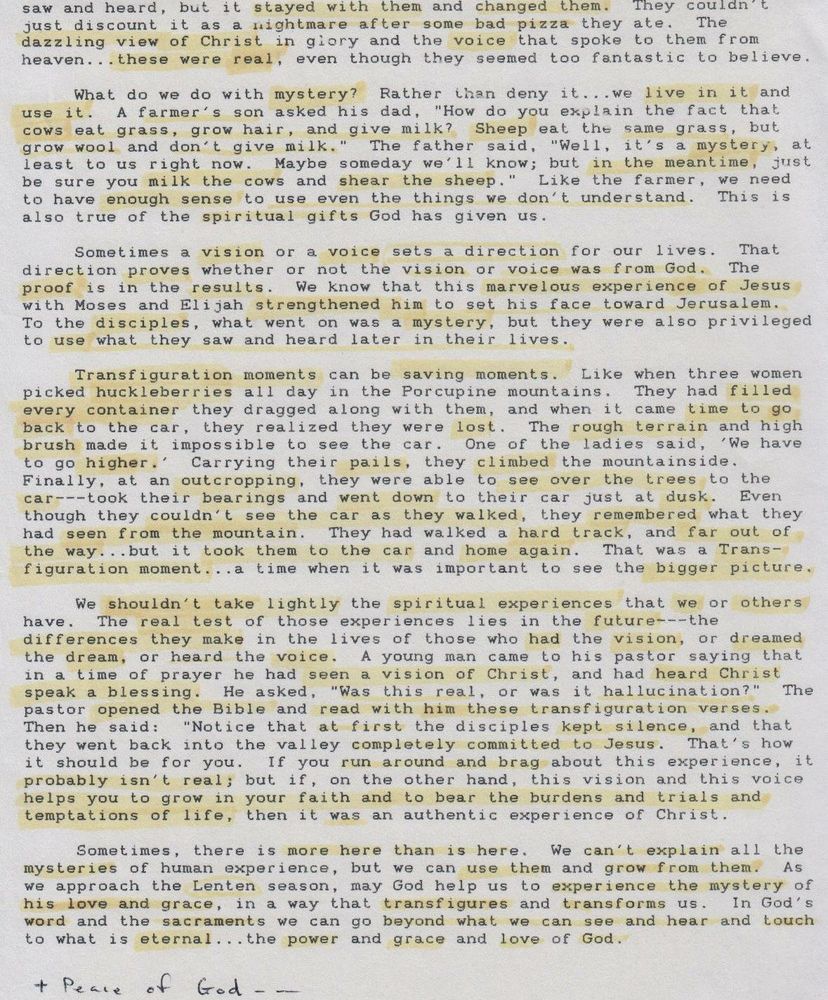I found two copies of this sermon in the archives - one was black and white, the other was higlighted. I’m including the highlighted version here.
This is a sermon from 1995, preached for Transfiguration Sunday C.
The sermon refers to “A Study of Generations”. I’ve found an article referring to the study in PDF form here.
Here’s a link to the actual study.
WHEN THERE’S MORE HERE THAN IS HERE (2/26/95) Luke 9:28-36
Dear friends in Christ, grace & peace….
What is real? That is a question that asked by children, philosophers, and many of us adults at some point in our lives. Part of our growing up is dedicated to finding out what is real—-really important, really worth our time.
Part of us says what is real is what we can see and touch…tables and chairs, money and houses and trees and rocks. But there is also a part of us that knows of real things that can’t be easily seen or touched. A landmark study of Lutherans, called A study of Generations, found that 50% of the hundreds of Lutherans they interviewed had at least one experience with the holy that they could not explain (i.e., a voice in the night, a war-time experience, healing or a vision). Many were hesitant to talk about these experiences, not because they weren’t real, but because they didn’t want to sound wierd or crazy.
A pastor offered to take down an old birch tree in the yard of a parishioner. After cutting it down and loading the wood, the man invited the pastor to take a break, and as they sat and had a snack, the man said he wanted to share something he hadn’t told anyone in over 40 years. This sounded like a pretty heavy conversation for a pastor’s day off, but he said to go ahead. He told in vivid detail an event of D-day plus 8. He had hit the beach at Normandy on D-day plus 4. Four days later in the hedgerow country, he felt a hand push him hard from behind, just as German machine guns started shooting at him from behind a hedgerow a few yards away. He lay with his face in the mud for a few minutes with bullets zinging over his head until members of his platoon took care of the machine gunner with some mortars. Later that evening, he went to find whoever had pushed him in the mud, to thank him for saving his life. What he heard from his fellow platoon members was, “Funny you should mention that. We saw you out there ahead of us, we saw you hurled down, but nobody was there to push you.” ‘Pastor, I’ve wondered about this for 40 years. What am I to make of it?’ Indeed, sometimes there is more here than is here.
About 20 years ago Joyce and I were at a fish fry and sat with some relatives of parishioners. I knew the man had recently had bypass surgery and asked him about it. I wasn’t quite prepared for his description of what had happened in the room before surgery, when his heart stopped for over four minutes. It was a strange experience, and I had not yet read some of the books about near death experiences. He did not asked me if what he experienced was real….it was very real, even though no one else saw what he saw. Sometimes there is more here than is here.
If we add up all that we can see and touch in this world, all the tables and chairs and beds and flowers and mountains, all the physical objects…those things are real—but there is more. There are spiritual realities beyond the physical that some people scoff at and deny. But those who have experienced these spiritual realities know that there is more to it than what the world says is real.
How do we know these spiritual things are real? We know that they are real because they change lives. The disciples never forgot what they saw up there on the mountain with Jesus. They may have tried to deny what they saw and heard, but it stayed with them and changed them. They couldn’t just discount it as a nightmare after some bad pizza they ate. The dazzling view of Christ in glory and the voice that spoke to them from heaven…these were real, even though they seemed too fantastic to believe.
What do we do with mystery? Rather than deny it…we live in it and use it. A farmer’s son asked his dad, “How do you explain the fact that cows eat grass, grow hair, and give milk? Sheep eat the same grass, but grow wool and don’t give milk.” The father said, “Well, it’s a mystery, at least to us right now. Maybe someday we’ll know; but in the meantime, just be sure you milk the cows and shear the sheep.” Like the farmer, we need to have enough sense to use even the things we don’t understand. This is also true of the spiritual gifts God has given us.
Sometimes a vision or a voice sets a direction for our lives. That direction proves whether or not the vision or voice was from God. The proof is in the results. We know that this marvelous experience of Jesus with Moses and Elijah strengthened him to set his face toward Jerusalem. To the disciples, what went on was a mystery, but they were also privileged to use what they saw and heard later in their lives.
Transfiguration moments can be saving moments. Like when three women picked huckleberries all day in the Porcupine mountains. They had filled every container they dragged along with them, and when it came time to go back to the car, they realized they were lost. The rough terrain and high brush made it impossible to see the car. One of the ladies said, ‘We have to go higher.’ Carrying their pails, they climbed the mountainside. Finally, at an outcropping, they were able to see over the trees to the car—took their bearings and went down to their car just at dusk. Even though they couldn’t see the car as they walked, they remembered what they had seen from the mountain. They had walked a hard track, and far out of the way…but it took them to the car and home again. That was a Transfiguration moment…a time when it was important to see the bigger picture.
We shouldn’t take lightly the spiritual experiences that we or others have. The real test of those experiences lies in the future—the differences they make in the lives of those who had the vision, or dreamed the dream, or heard the voice. A young man came to his pastor saying that in a time of prayer he had seen a vision of Christ, and had heard Christ speak a blessing. He asked, “Was this real, or was it hallucination?” The pastor opened the Bible and read with him these transfiguration verses. Then he said: “Notice that at first the disciples kept silence, and that they went back into the valley completely committed to Jesus. That’s how it should be for you. If you run around and brag about this experience, it probably isn’t real; but if, on the other hand, this vision and this voice helps you to grow in your faith and to bear the burdens and trials and temptations of life, then it was an authentic experience of Christ.
Sometimes, there is more here than is here. We can’t explain all the mysteries of human experience, but we can use them and grow from them. As we approach the Lenten season, may God help us to experience the mystery of his love and grace, in a way that transfigures and transforms us. In God’s word and the sacraments we can go beyond what we can see and hear and touch to what is eternal…the power and grace and love of God.

